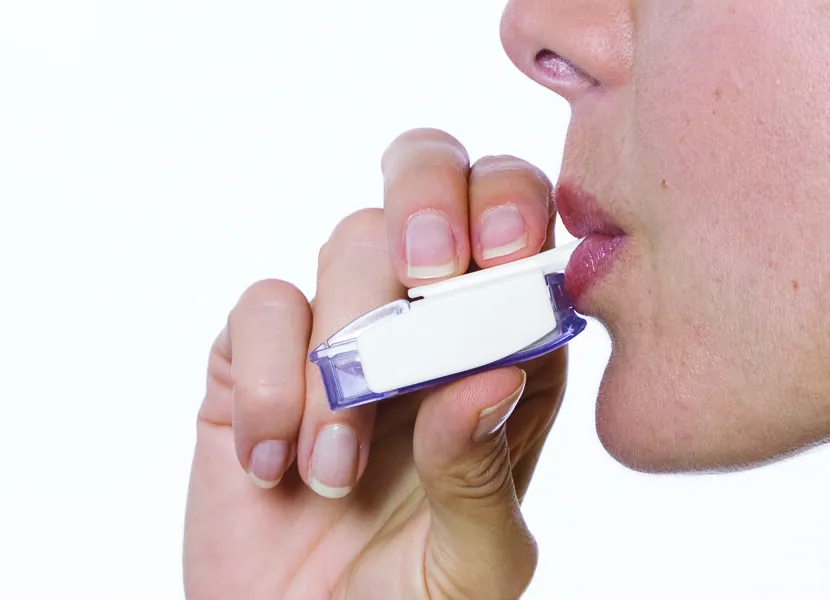All About Inhaled Insulin

Inhaled insulin has been around for a while, but if you have not heard of it, this article will get you up to speed. Inhaled insulin can be used by those who use mealtime insulin, regardless of diabetes type.
I’ve been using inhaled insulin for nearly five years, and I can’t imagine managing type 1 diabetes without it. Many people may be hesitant to try it because Afrezza inhaled insulin is so different than injected insulin. It’s hard to imagine how it could possibly work for someone with diabetes. I get it – I was very skeptical and reluctant to try it too! Today I use inhaled insulin for most of my mealtime and correction insulin needs. I still use a small amount of rapid-acting insulin every day, as well as long-acting insulin.
Here’s what you need to know about inhaled insulin.
It works really, really fast.
Afrezza comes in 4-unit, 8-unit or 12-unit cartridges. It has an onset time of 10 minutes, peaks in 35 to 45 minutes, and lasts for 90 to 180 minutes. When Afrezza is taken at the beginning of a meal, it starts lowering blood glucose in as little as 12 minutes. And just as Afrezza enters the body quickly, it also leaves fast – within 1.5 to 3 hours, depending on the dose.
To really grasp the speed of inhaled insulin, I had to let go of all the “rules” I had learned about it. This is a completely different way for me to dose insulin for food or above-range blood glucose. I find I can correct a blood glucose of 250 mg/dL in one hour using Afrezza.
The speed of Afrezza also makes a few other things easier for me:
- I don’t need to pre-bolus for most meals.
- I can easily add to my insulin dose if I’m unsure how much I’ll eat.
- I can react quickly if I forget to take my mealtime dose altogether.
- I can quickly correct above-range blood glucose, meaning less guilt and frustration.
- I generally worry less about being out of range because I know I can treat so quickly.
It makes it easier for me to exercise.
Perhaps my favorite thing about Afrezza is how quickly it clears my system and the impact this has on my exercise routine. The 4-unit cartridges clear my system in about one hour, and the 8- and 12-unit cartridges clear in less than two hours. This means a few things for my T1D when exercising:
- I worry less about hypoglycemia during exercise if it’s been an hour since my last inhaled insulin dose.
- It’s easier to plan to exercise when I have very little insulin on board.
- I can exercise an hour after eating a meal without consuming extra carbs because the meal dose has cleared (or mostly cleared) my system!
- I have fewer lows overall because I have less insulin on board.
When I’m taking injections of rapid-acting insulin, which lasts 4 to 5 hours, there’s nearly always insulin on board. This makes it hard for me to exercise without eating extra food I didn’t want. Inhaled insulin completely simplifies this.
It’s easier for me to prevent and treat below-range glucose.
When first starting on inhaled insulin, you might experience a few wild lows because you’re still learning how it works. I remember impatiently taking a dose of inhaled insulin on top of an injection of rapid-acting insulin in an effort to correct an abore-range blood glucose. Wow, I learned my lesson. It’s very important to practice and monitor how your body will respond to each dose.
After getting through that first week or two, I find that I have significantly reduced instances of lower blood glucose, and the lows I do have require far fewer carbohydrates to treat. This is all thanks to the speed of inhaled insulin. It’s fast, but it doesn’t set up camp like an injection of rapid-acting. It just pops in, does its thing, and pops out.
For example, if my blood sugar is dropping, and my continuous glucose monitor says I’m at 90 mg/dL with a down arrow, but it’s been one hour since I took a small dose of inhaled insulin, I don’t really worry about going low because I know it’s just about out of my system. For me, mild lows rebound on their own if I’m still digesting food. However, it’s important to continue monitoring to ensure you stay in range.
The most annoying thing about inhaled insulin: sometimes it’s out too fast.
Okay, so the speed of inhaled insulin is awesome, except when I want it to last a little longer. For meals that digest really slowly, I find using a combination of inhaled insulin and injected insulin is helpful.
Since most meals are not digested in one hour, or even two, I often need “follow-up” doses in the hours after eating, depending on my speed of digestion. While this may be tedious if you want to avoid juggling additional doses, it can also give me a lot of flexibility. If I plan to
walk my dog within an hour of eating, I can reduce my “follow-up” dose to account for the exercise. Every now and then, I forget about that follow-up dose, but that’s when my CGM helps me. When it hits 150 mg/dL, I know it’s time for a second dose.
Common quick questions
- Does inhaled insulin cause lung cancer? In studies of Afrezza in people with diabetes, there were too few cases to know if lung cancer was related to Afrezza. Talk to your healthcare provider if you have concerns or lung issues.
- I heard it can make you cough — is that true? Most people report a cough for the first month, then it goes away. I learned that taking a sip of water before dosing helps me.
- Can you use inhaled insulin with a pump? Many people who use manual insulin pumps use inhaled insulin, especially to correct above-range blood glucose levels.
- How do you know what to dose for meals? It can take some trial and error to figure out mealtime dosing, and you should work closely with your healthcare team during this time. Monitoring is essential. It took me about a month to really get a good handle on it.
- Do I still need to take long-acting insulin? Inhaled insulin does not replace your background (or basal) insulin needs. It is only taken for meals and corrections.
- Does it taste funny? Nope, no smell or taste. I don’t even feel it hitting my throat.
If you want to try it…
Getting inhaled insulin involves a few careful steps:
- If you have commercial insurance, check your plan for coverage and copay costs. You can also look for manufacturer coupons that can reduce out-of-pocket costs to as little as $35/month.
- Your doctor cannot simply send the prescription to your normal pharmacy. It is likely to be rejected.
- Mannkind (the makers of Afrezza) and Sterling Specialty Pharmacy can help you! They can work with your doctor and the insurance company to get the right paperwork. More information can be found at www.afrezza.com/paying-for-afrezza.
- Your doctor must document “lipohypertrophy” in your medical records. Lipohypertrophy is the accumulation of hardened fat cells that develop from repetitive insulin injections. You likely have this, even if you’re not aware of it. Your doctor should document any mealtime insulins you have tried and experienced a treatment failure with in your medical records. Your doctor must also explain why your current insulin methods are insufficient. Reasons may include things like “injection fatigue,” “post-meal spikes in blood sugar,” etc.
- If your appeal is also denied, look into the AfrezzaAssist program, which offers a $99 cash pay option for commercially insured patients who are denied coverage by their insurance plan.
I also explain the details in a video right here.
A little recap
If you want to try something different, inhaled insulin is a whole new game. Personally, I found it kind of refreshing after 20 years of taking injections or using a pump. It was fun to learn something so different. It feels much more flexible than my injected insulin – every dose is less of a commitment because it’s in and out of my system so quickly. I’m glad I tried something totally different with inhaled insulin.
Interested in learning more about inhaled insulin?
Join us for two exciting upcoming events! Sign up for a webinar with Diana Isaacs, PharmD, BCPS, BC-ADM, CDCES: Discover the benefits and practical tips for using inhaled insulin.

And join us for a workshop with Ginger Vieira, diabetes expert and advocate: Dive deeper into how inhaled insulin can fit into your diabetes management plan. Attend either at 12:00 PM ET or 7:00 PM ET.


Don’t miss these opportunities to get valuable insights and have your questions answered!
Ginger Vieira has lived with type 1 diabetes since 1999, along with a few other chronic illnesses! She has authored hundreds of articles and several books, including Exercise with Type 1 Diabetes, Pregnancy with Type 1 Diabetes, Dealing with Diabetes Burnout, and Stop Overeating During Lows. Her background includes a Bachelor of Science in professional writing and certifications in coaching, personal training, powerlifting, and Ashtanga yoga. Find Ginger: GingerVieira.com,
Image from Mannkind.
Written by






